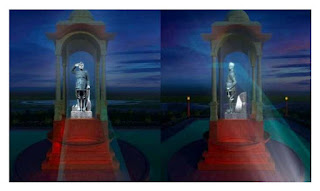বাংলা নির্বাচন ২০২১ ফলাফলের উপর 'বঙ্গদেশে' প্রকাশিত আমার নিবন্ধ।
https://www.bangodesh.com/2021/05/bengal-future-game/
পশ্চিমবঙ্গ বিধানসভা নির্বাচন ২০২১ শেষ। রেকর্ড সৃষ্টি করে মুখ্যমন্ত্রী মমতা ব্যানার্জি তৃতীয়বারের জন্য ক্ষমতায় ফিরে এলেন। যে ‘হাইপ’ নিয়ে বিজেপি স্বপ্ন দেখিয়েছিল ‘বাংলা জয়’ করার, তা আপাতত শেষ। ‘খেলা হবে’ শেষ; কিন্তু আরেকটি ‘খেলা শুরু’ হচ্ছে?
প্রথমেই ধন্যবাদ জানাই ভারতীয় নির্বাচন কমিশনকে। এই প্রথম নির্বাচন-পর্বে আগের তুলনায় অনেক কম নির্বাচনী-হিংসা সংঘটিত হতে পেরেছে। শীতলকুচির মর্মান্তিক ঘটনা নিশ্চয়ই আমাদের ভবিষ্যতে নির্বাচনী-সংঘর্ষ কম রাখতে মনে করাবে। একই সঙ্গে নির্বাচন-পরবর্তী হিংসা বাঙালি সমাজকে আবারও গ্রাস করে চলেছে। এর শেষ কোথায়?
এবার কয়েকটি কথা, কিছু বিশ্লেষণ। এই নির্বাচন আবার প্রমাণ করল যে, বাঙালি সমাজ মূলত এক ‘দ্বি-মেরু’, ‘দ্বি-পক্ষীয়’- ‘বাইনারি’ রাজনৈতিক-সমাজ, যা ‘আমরা-ওরা’, ‘এপক্ষ-ওপক্ষ’, ‘মিত্রপক্ষ-শত্রুপক্ষ’-বিভক্ত একটি ‘পার্টি-সমাজ’। এখানে বিরোধীপক্ষ বলে কিছু নেই, আছে শত্রুপক্ষ। এই বাঙালি ‘বাইনারি’ জাতি-বৈশিষ্ট্য স্বাধীনতার পর থেকেই ভারতীয় বাঙালি সমাজ দেখে চলেছে। প্রথমে ‘কংগ্রেস-বাম’, পরে ‘বাম-কংগ্রেস’, তারপরে ‘বাম-তৃণমূল’। তারপরে ‘তৃণমূল-বাম’। এবার ‘তৃণমূল-বিজেপি’। কাজেই, যে কারণগুলোর জন্য এক পার্টি জয়লাভ করে, ঠিক সেই ফ্যাক্টরগুলোই অপর পার্টির পরাজয়ের কারণ হয়ে দাঁড়ায়।
প্রথম, নির্বাচনের লেভেল। মনে রাখতে হবে, এই নির্বাচন কোন জাতীয় নির্বাচন নয়, রাজ্য নির্বাচন। এটা এখন সুস্পষ্ট যে, ভারতীয় ভোটাররা জাতীয় ও রাজ্য নির্বাচনের পার্থক্য খুব ভালোভাবেই বোঝে, আর সেই ভাবেই ভোট দেন। আজকের পশ্চিমবঙ্গের বাঙালি ভোটাররা সেটা বুঝিয়ে দিয়েছেন। তাই ২০১৯ জাতীয় নির্বাচনে প্রায় ৪০ শতাংশ ভোট দিয়ে বিজেপিকে ১৮ জন এমপি দিয়েছিল। আর এখন বিধান সভায় ৩৮ শতাংশ ভোট দিয়ে এই পাঁচ বছরে ৩ থেকে বিজেপিকে ৭৭ জন এমএলএ সিট দিয়েছে। এই নির্বাচনে তৃণমূল ও বিজেপি সেই অর্থে ২০১৬ বিধানসভার নিরিখে লাভবান হয়েছে। ২০১৬ বিধানসভায় ১০ শতাংশ ভোট থেকে বিজেপি এখন পরিপূর্ণ বিরোধী শক্তি হিসেবে ৩৮ শতাংশ ভোট পেয়েছে। আবার, ২০১৬ সালের সাপেক্ষে তৃণমূল তার সিট এবং ভোট শতাংশ বাড়িয়ে নিয়েছে। বাম-কংগ্রেস শক্তি প্রায় নিশ্চিহ্ন হয়ে গেছে। আর, রাজ্য ভিত্তিক নেতৃত্বের কোনো ‘বিকল্প’ না থাকার জন্যেই বিজেপি বা অন্য তৃতীয় শক্তির উপর বাঙালি সমাজ নির্ভর না করে মমতা ব্যানার্জির ওপরই আস্থা রেখেছে।
দ্বিতীয়, ‘বহিরাগত ইস্যু’ ও ব্যক্তিগত আক্রমণ। প্রথম থেকেই মমতা ব্যানার্জি বিজেপির দিল্লির নেতৃত্বের আক্রমনকে ‘বহিরাগত আক্রমণ’ হিসেবে দেখাতে পেরেছেন। এই ‘বহিরাগত আক্রমণ-তত্ত্ব’কে প্রতিহত করতে বিজেপি নেতৃত্ব পুরোপুরি ব্যর্থ হয়েছে। ২০১৯ সালের সাফল্যের পর থেকে বিজেপি নেতৃত্ব বাংলা-ভিত্তিক নেতৃত্বকে ‘গ্রুম’ করে উঠতে পারেনি। মমতা ব্যানার্জি ঠিক এখানেই নিজেকে ‘বাংলার মেয়ে’- ভূমিকন্যা হিসেবে নিজেকে পুরোপুরি বাঙালি-মানসে প্রতিষ্ঠিত করতে পেরেছেন। আবার, শুধুমাত্র নির্বাচনের সময় কেন্দ্রীয় এজেন্সিগুলো দিয়ে কয়লা, গরু, কাটমানি, তোলাবাজী-চক্রের বিরুদ্ধে ‘পিসি-ভাইপো’কে ‘ব্যক্তিগত আক্রমণ’ তথা মমতা ‘বেগম’ বলে মহিলা-হিসাবে আক্রমণ সাধারণ বাঙালি একেবারেই গ্রহণযোগ্য মনে করেনি, বরং তা বিজেপির পক্ষে ‘কাউন্টার-প্রোডাকটিভ’ হয়ে গেছে। বিজেপির কেন্দ্রীয়-নেতৃত্বের ‘বাংলা-অর্জনের’ পরিবর্তে ‘বাংলা-দখলের’ আগ্রাসী মানসিকতাকে আপামর বাঙালি প্রত্যাখ্যান করেছে।
তৃতীয়, প্রার্থী-নির্বাচন। তৃণমূল থেকে আসা প্রায় সমস্ত ‘দলবদলু’দের বিজেপি যে প্রার্থী করল, সেখানেই মমতা ব্যানার্জি চরম ফায়দা তুলতে পেরেছেন। এই দলবদলুদের ‘বিশ্বাসঘাতক’, ‘গদ্দার’, তথা ‘মিরজাফর’ হিসেবেই বাঙালি সমাজ প্রত্যাখ্যান করেছে; শুধুমাত্র সুবিধা লাভের জন্য, আসন্ন ক্ষমতা-পদের জন্য এই সমস্ত প্রার্থীদের বিপরীতে তৃণমূল প্রার্থীদেরকে ‘দুর্নীতিগ্রস্থতা’র মাপকাঠিতে কোনোই ‘প্রার্থক্য’ করেনি। মাটি-কামড়ে পড়ে লড়াই-করা দলীয় কর্মীদের বেশি হারে প্রার্থী না করা বিজেপির বিপক্ষে গেছে। এমনকি, বর্তমান এমপিদের প্রার্থী করাকে বিজেপির ‘রিজার্ভ বেঞ্চ-ডেফিসিট’ হিসেবেই এই বাংলা ধরেছে।
চতুর্থ, মহিলা-ভোটার। মহিলা সশক্তিকরণের জন্য বিভিন্ন মহিলা-কেন্দ্রিক কেন্দ্রীয় প্রকল্পের সুবিধা সর্বভারতীয় ইলেকশনে নরেন্দ্র মোদী যেমন পেয়েছেন, ঠিক একইভাবে রাজ্যস্তরে মহিলা প্রকল্পগুলি মমতা ব্যানার্জিকে গত ১০ বছর ধরে সেই একই ডিভিডেন্ট দিয়ে চলেছে। এছাড়া মমতা ব্যানার্জির ‘ঘরের মেয়ের’ এপ্রোচ বাংলার মহিলাদের কাছে ওনাকে আরো বেশি ‘নির্ভরযোগ্য’ করে তুলেছে। তার ‘নরম সুরের আহ্বান’কে বাংলার মেয়েরা নিজের করে নিয়েছে।
পঞ্চম, কমিউনিকেশনস ফ্যাক্টর। বাংলার নির্বাচনে ভাষা একটা বড় ফ্যাক্টর। দিল্লির কেন্দ্রীয় নেতৃত্বের লাগাতার হিন্দিতে ‘গ্র্যান্ড প্রচার’ বাংলার সাধারণ মানুষ নিতে পারেনি, যা বাংলার সংস্কৃতি-কৃষ্টিকে ‘ভাষাগত আক্রমণ’ আক্রমণ হিসেবেই ধরা হয়েছে। মমতা ব্যানার্জি এই ভাষাকেন্দ্রিক ক্যাম্পেইনের সুবিধা গ্রহণ করেছেন; বিজেপি নেতৃত্বের হিন্দি-ভাষাকেন্দ্রিক প্রচারের ব্যর্থতাকে পুরোপুরি কাজে লাগিয়েছেন। মমতা বরাবরের মতো সহজ সরল ‘মেঠো’ বাংলায় সরাসরি ভাষায় দিল্লি-নেতৃত্বকে আক্রমণ করে ফায়দা তুলেছেন।
ষষ্ঠ, এককাট্টা মুসলিম-ভোট। এবারের নির্বাচনে বাঙালি মুসলিমদের সাপেক্ষে এক দিক-পরিবর্তন- ‘প্যারাডাইম শিফট’ ঘটেছে। এই প্রথম মালদা, মুর্শিদাবাদ-সহ বাংলার সব অঞ্চলেই বাম-কংগ্রেস জোটকে বাঙালি মুসলিম জাতি পুরোপুরি প্রত্যাখ্যান করেছে। সমস্ত মুসলিম ভোট মমতা ব্যানার্জির পক্ষে গিয়েছে। একদিকে বিজেপির ‘চরম হিন্দুত্ববাদ’ থেকে বাঁচা, আরেক দিকে মুসলিম জাতির পরিচয়-সত্তার ‘অস্থিত্ব রক্ষার’ জন্য মুসলিমরা মমতা ব্যানার্জিকে ‘রক্ষাকর্ত্রী’ হিসেবে বেছে নিয়েছে; কোন দ্বিতীয় পক্ষের জায়গা রাখেনি। তবে মুসলিম ধর্মগুরুর নেতৃত্বে আইএসএফ এখানে লাভ পেয়েছে, একটা সিট পেয়েছে; যা ভবিষ্যতে বাংলার মুসলিম জনবিন্যাসে ধীর অথচ নিশ্চিত পরিবর্তনের সাপেক্ষে মুসলিম জাতিশক্তিকে একটি ‘পরিচালক-শক্তি’ হিসেবে প্রতিষ্ঠিত করতে পারে।
সপ্তম, সোশ্যাল ইঞ্জিনিয়ারিং ইস্যু। স্বাধীনোত্তর পশ্চিমবাংলায় বামপন্থী ধারায় শ্রেণীসংগ্রামের প্রায়োগিক ফলিত চর্চা যা হয়েছে, সেই ধারাকে প্রায় সম্পূর্ণ পাল্টে দিয়েছেন মমতা ব্যানার্জি ক্ষমতায় আসার পর। সর্বভারতীয় স্তরে বিজেপি এসসি/এসটি/ওবিসিদের নিয়ে যে সোশ্যাল ইঞ্জিনিয়ারিং পরীক্ষা করেছে, সে একই পরীক্ষা বাংলার বুকে করেছেন মমতা ব্যানার্জি। বিভিন্ন ভাষিক-গোষ্ঠী, আদিবাসী, জনজাতি, নিম্নবর্গ-গোষ্ঠী তথা মুসলিম-গোষ্ঠীকে ওবিসি-সংরক্ষণ- প্রায় সবধরনের জনগোষ্ঠীকে কায়েমী স্বার্থ তথা ক্ষমতার অংশীদারিত্বের ভাগীদারি করেছেন। এমনকি হিন্দি-ভাষিক গোষ্ঠীও এই জন-ক্ষমতার অঙ্গীভূত হয়েছে। বিজেপিও এবার বাংলায় এই সোশ্যাল ইঞ্জিনিয়ারিং করে রাজবংশী, মতুয়া, আদিবাসী ডিভিডেন্ড পেয়েছে। তবে লাভ বেশি পেয়েছেন মমতাই তার নেতৃত্বের কারণেই।
অষ্টম, ‘নরম-চরম’ হিন্দুত্ব ইস্যু। হিন্দুত্ব বা ‘হিন্দুনেস’ বাঙালি হিন্দু সমাজে সবসময়ই ‘নরম’ প্রকৃতির। উত্তর-ভারতের ‘মর্যাদাপুরুষোত্ত্ম’ শ্রীরামচন্দ্র বাঙালি হিন্দুর কাছে ‘ঘরের লোক নন, বাইরের লোকও নন’; তিনি ঘরের সামনেই থাকেন। কিন্তু, বাঙালি হিন্দুর ঘরে আছেন ‘মা কালী’ আর শ্রীচৈতন্য মহাপ্রভুর ‘লীলাপুরুষোত্ত্ম’ বংশীধারী শ্রীকৃষ্ণ। সর্বোপরি, ‘মা দুর্গা’ তো বাঙালি হিন্দুর ‘আইকন’, যে ‘ঘরের মেয়ে’! এই ‘নরম’ হিন্দুত্বের সামনে ‘জয় শ্রীরাম’ হয়ে দাঁড়িয়েছে ‘চরম’ হিন্দুত্বের ‘আগ্রাসী’ এক ‘পলিটিক্যাল শ্লোগান’, যা বাঙালি হিন্দু সর্বতোভাবে প্রত্যাখ্যান করেছে।
নবম, ‘ভদ্রলোক-প্রান্তিক’ বাঙালি ন্যারেটিভ। এই ইস্যু আমার কাছে খুব প্রাসঙ্গিক মনে হয়েছে। উনবিংশ শতাব্দী থেকেই ‘নবজাগরণের’ ধারায় বাঙালি সমাজে এক কলকাতা-কেন্দ্রীক ‘শহুরে’ উদার ‘বর্ণহিন্দু’-ভিত্তিক মানবতাবাদী এক ‘ডমিন্যান্ট’ ‘ভদ্রলোক-বাঙালি’ ন্যারেটিভ গড়ে উঠেছে; যার বিপরীতে প্রায় লুক্কায়িত ক্ষমতা-বৃত্তের বাইরে ‘গ্রামীণ’ ‘প্যাসিভ’ এক ‘প্রান্তিক-বাঙালি’ ন্যারেটিভও অন্তর্লিন হয়ে বয়ে চলেছে। আজকের নির্বাচনী ফল দেখিয়ে দিয়েছে সাধারণ বাঙালি সমাজে সেই ‘ভদ্রলোক-বাঙালি’ ন্যারেটিভের নিঃসন্দেহ ডমিন্যান্স। তবে, বিজেপি কিন্তু ‘প্রান্তিক-বাঙালি’র সমর্থন পেয়েছে।
দশম, ‘বাঙালির বঞ্চনা’। এটা তো অস্বীকার করার জায়গা নেই যে, ভারতের স্বাধীনতালাভের মূল্য সব থেকে বেশি চোকাতে হয়েছে বাঙালি জাতিকে। আবার, বাংলাদেশ হওয়ার পর বাঙালি জাতির ‘রাজনৈতিক সত্তা’ দ্বিধাবিভক্ত। ভারতীয় বাঙালি জাতিসত্তা এখন শুধুমাত্র ‘সামাজিক’। সর্বভারতীয় রাজনৈতিক স্তরে বাঙালি জাতিসত্তা স্বাধীনতার পর থেকেই ‘উপেক্ষিত’ তথা ‘মার্জিনালাইজড’। ‘অস্মিতা’ শব্দের পরিবর্তে ‘অহং’ শব্দটি বেশি খাটে। ‘বাঙালি-অহং’ এই ‘বঞ্চনায়’ ক্ষত-বিক্ষত হয়েই চলেছে। এই ক্ষতকেই ক্রমাগতভাবে বাম-শাসকরা, পরে মমতা ব্যানার্জিও সুচারুভাবে ‘তুলে’ ধরতে পেরেছেন। স্থানীয় নেতৃত্বকে না তুলে ধরে বিজেপি ‘বাইরের নেতৃত্ব’ দিয়ে এই ‘বাঙালি-অহং’কে উপেক্ষা করেছে। ফল যা হওয়ার তাই হয়েছে।
এবার সামনের কথা। ‘খেলা শেষ’- খন্ড-যুদ্ধ বা ‘ব্যাটেল’ শেষ হয়েছে; কিন্তু ‘বড় যুদ্ধ’ বা ‘ওয়ার’ মনে হয় শুরু হলো। বাঙালি সমাজ ‘মেরুকৃত’ই থাকল, যেখানে ‘নিরঙ্কুশ’ বিরোধীপক্ষের ভূমিকায় এক প্যারাডাইস শিফট ঘটলো ‘দক্ষিণপন্থী’ বিজেপির উত্থানে; যার বিপরীতে দাঁড়িয়ে রয়েছে এক জনমোহিনী ‘পপুলিস্ট’ রাজনৈতিক শক্তি। তবে বৃহত্তর ইস্যুগুলো রয়েই গেল। যেমন, শিল্পায়ন, কর্মসংস্থান, স্বচ্ছ সরকারি চাকরি-পরীক্ষা, রাজ্যে পরিযায়ী শ্রমিকদের কাজের অভাব, কাটমানি, সিন্ডিকেট, পাচার-চক্র, অনুপ্রবেশ ইত্যাদি। ‘উন্নততর বাংলা’ গড়তে কোন পক্ষ কেমন পথ-দিশা দেখাতে পারে, কি ধরনের কর্মসূচি নিতে পারে, সে সবের দিকেই তাকিয়ে আছে আপামর সাধারণ বাঙালি সমাজ
@ সুজিৎ রায়
নোট: ২০১৯ সাধারণ নির্বাচন নিয়ে আমার লেখা পড়তে পারেন এখানে।


















